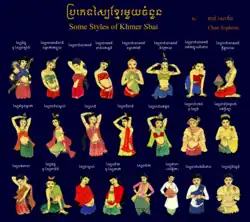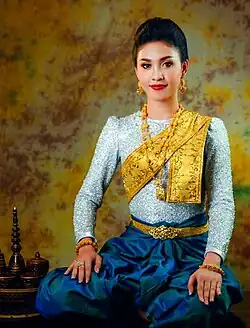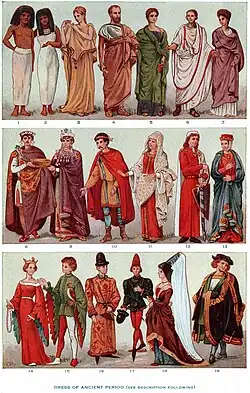Sbai
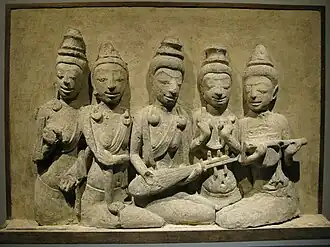
Sbai (Khmer: ស្បៃ [sɓaj]; Lao: ສະໄບ [sā.bàj]; Malay: Sebai; Jawi: سباي; Thai: สไบ, RTGS: sabai [sā.bāj]) or phaa biang (Lao: ຜ້າບ່ຽງ [pʰȁː bīaŋ]; Thai: ผ้าเบี่ยง [pʰâː bìaŋ]) is a traditional shawl-like garment worn by women in Cambodia, Laos, and Thailand to cover the breasts, while in Sumatra, Borneo and the Malay Peninsula, the same term is used to describe a cloth hanging from the shoulders.[1]: 410 Historical evidence suggests the sbai was shaped by cultural exchanges with South Asia, where garments such as the Indian sari and duppata influenced its style. Though, the sbai differs from the sari and duppata through Southeast Asian weaving and symbolic practices.[2][1][3]
Etymology
The term sbai is the contracted form of vowels which ultimately has its roots from the Austronesian term *cahebay,[4][5] which was diversified under the first exodus in Taiwan as the Formosan term *sapay[4][6] from South China between 5,000–4,500 BCE, and the second exodus to the Philippines and Indonesia, with others occurring around 3,000–2,000 BCE.[7]
Its vowel sequence was contracted from south China to the first exodus: *cahebay→*cahbay→*cahpay→*sapay (meaning: 'to hang').[6] According to the Proto-Austronesian Phonology of Cornell University Southeast Asia Program (SEAP), there is the diversity of the term *cahebay or *sapay into subgroups of other languages families as follows:
- Austroasiatic languages: *lɓak (Dvaravati Old Mon and Nyah Kur),[8] cambāy (Middle Mon), *jbaay (Mon), *sapay→sĕbai, sbai→sbāy, spai→spiey or *sapay→spai→spiey (Old Khmer and Modern Khmer),[9] phìai (Kuy).
- Austronesian languages: *cahebay→łahpay, cahfay, cabfay. (Proto-Austronesian).[6]
- Formosan languages: *sapay→sapai (Puyuma).[4]
- Indo-European languages: *səmpay (Sangsari).[4]
- Kra–Dai languages: *sapay→sĕbai, sbai→sabai, saphaay (Thai, Lao).[10][11]
- Malayo-Polynesian languages: *sapay→sbai,[12] sĕbai,[13] sampai (Malay), sampai (Indonesian), sampay, sampayán (Tagalog), sampe (Makassarese, Serayar), sambay, sablay (Maranao), sumpáy (Ratahan), hafe-hafe (Tondarno), cave- (Filipino), sappɛ (Buginese), sappɛ-sappɛ (Toba Batak), sampay-an (Ngaju), sampe-lao (Muna), sampi, mi-sampy, sampazana (Malagasy), sambay (Maranao).[4]
- Indo-European languages: spāy (unverified Sanskrit religious vocabulary as assumed by French.) from a Sanskrit Khmer inscription on the Tāmrakumbha Indian brass water jug (K.669C Line 18) aged 972 CE at Preah Vihear Temple.[14]
- Dravidian languages: calvai, cālvai, sālvai, sâlvai (Tamil),[15][16] from Modern Persian šāl[17] or Urdu and Persian chal, shal, shàl.[18]
History
The sbai is part of a tradition of unstitched garments that evolved from a long history of cultural exchange and indigenous innovation. Its form and the materials used to create it, such as silk and cotton, were significantly influenced by Indian textiles and fashion such as the sari and dupatta.[5] The sbai and other draped clothing styles emerged from a dynamic process of synthesis between local traditions and the cultural and commercial influences that came to the region via extensive trade networks and early kingdoms like Funan, Srivijaya, Dvaravati, and the Khmer Empire.[2] These interactions led to the adoption and reinterpretation of foreign elements into distinct Southeast Asian forms, in a process of mutual exchange.[3]
Cambodia
There are multiple texts and stories in Khmer culture concerning the history of the sbai, which was likely introduced during the Funan era from India alongside chong kben in the first century AD, making it one of the earliest major civilizations to use the sbai. The sbai is mentioned in the legend of Preah Thong and Neang Neak. In one scene, Preah Thong clings to a piece of cloth worn on the Nagini in order to make the journey to the Nāga's kingdom; that piece of cloth is a sbai. In that tale, the sbai is represents the tail of Neang Neak, the Nāga princess.[19][20]
During the Angkorian period, although it was common for men and women of lower status to be topless, clothes for the upper body, including the sbai, were worn amongst higher status individuals including nobles and royalty: the bas-reliefs of Bayon, Preah Khan, and other Angkorian temples depict women wearing sbais while religious male figures are adorned with stylized sbai. In Angkor Wat, there are depictions of topless Apsaras holding sbai connected to their sampot, while the northern wall of Angkor Wat depicts a group of ladies wearing long sbai holding various offerings.
Nowadays, sbai, along with chang kben and sampot, are regarded as Cambodia's national costumes.[21] A sbai most often used in traditional Khmer weddings with different type and decoration during the rite of Preah Thong Taong Sbai Neang Neak (transl. Preah Thong holding on to the sbai of Neang Neak) which represents the legend of the foundation of Funan and where the groom holds on to the bride's sbai as they go to their room. The groom also wears a sbai.[22]
For men, especially Brahmin and Buddhist monk, the sbai called sbong sbai trai chivor,[23] and is considered the robe of Hindu and Buddhist monks.[24] For women, sbai can be freely used and in different ways such as to wrapping it around the body, covering the shoulder, and commonly covering the breast and stomach over the left shoulder. Different styles of sbais are used by Cambodian women based on their preferences and traditions.
Laos

In Laos, this garment is known as phaa biang or sabai. It is common for Lao women to wear sabai as it is considered traditional clothing. A sabai can also be worn by men in weddings or when attending religious ceremonies. The type of sabai typically worn by Lao men often has checkered patterns. Sabai can also be a long piece of silk, about a foot wide, that is draped diagonally over the chest covering one shoulder with one end dropping behind the back.[25]
Malaysia
In Malaysia, the Sebai is a cloth wrapped around the neck to cover the shoulders with both ends hanging on the chest similar to a scarf hung over the shoulders.[26]
Myanmar
The ethnic Mon is also known to have similar tradition of wearing the shawl-like sabai called yat toot in Mon language, diagonally over the chest covering one shoulder with one end dropping behind the back like that worn by Lao women. This tradition distinguished them from other ethnic groups in Myanmar. The Mon people of Myanmar and Thailand today were the descendants of various Indianized polities, notably Dvaravati. Artifacts from Dvaravati sites in what is now Thailand depicted a group of ladies wearing early forms of the sabai.
Thailand

In Thailand, the garment is known as sabai or pha biang. The sabai was likely introduced into Thai culture during the Sukhothai era from Khmer and Dvaravati Mon peoples, and was used amongst nobles and royalty.[27][28] During the Ayutthaya and early Rattanakosin eras periods, the sabai became popularized amongst the general population as traditional attire. Sabais can be used by women or men. The sabai is a long piece of silk, about a foot wide, draped diagonally around the chest by covering one shoulder which its end drops behind the back. Sabais could be worn around a naked chest or layered on top of another cloth. The practice of wearing Sabais along with Victorian cloth was a common practice during the reign of King Chulalongkorn and lasted until the reign of King Vajiravudh when Westernized clothing became more fashionable.
Gallery
-
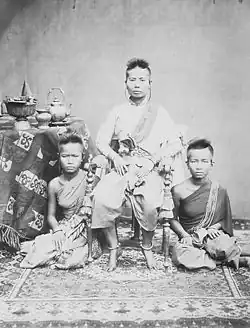 Queen Ang Mey and her daughters wearing a sbai in the 1800s
Queen Ang Mey and her daughters wearing a sbai in the 1800s -
 Lady Pun Bunnag, Somdet Chaophraya Borom Maha Sri Suriwongse's wife wearing a pha biang, 1866
Lady Pun Bunnag, Somdet Chaophraya Borom Maha Sri Suriwongse's wife wearing a pha biang, 1866 -
.jpg) Siamese girl wearing a pha biang, 1921
Siamese girl wearing a pha biang, 1921 -
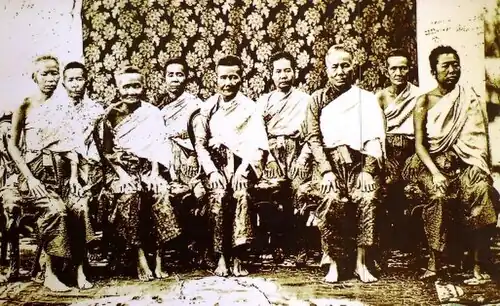 Daughters of King Rama II and King Rama III wearing a pha biang in the 1800s
Daughters of King Rama II and King Rama III wearing a pha biang in the 1800s -
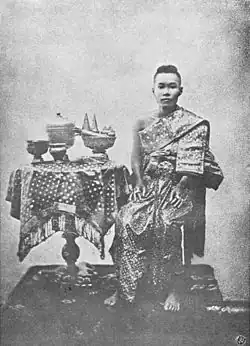 Queen Debsirindra wearing a pha biang, 1855
Queen Debsirindra wearing a pha biang, 1855 -
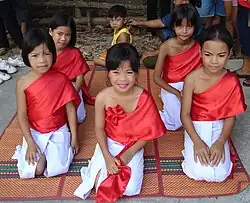 Thai children wearing a pha nung and a pha biang
Thai children wearing a pha nung and a pha biang -
 Cambodian bride wearing a sbai in a wedding ceremony
Cambodian bride wearing a sbai in a wedding ceremony -
.jpg) Traditional dancer wearing a sbai
Traditional dancer wearing a sbai
See also
- Sampot Chang Kben
- Khmer Traditional Dress
- Culture of Cambodia
- Chut thai
- Sampot
- Sampot Samloy
- Kemben
- Malaysian cultural outfits
- Sari
- Traditional Thai clothing
References
- ^ a b Maxwell, Robyn J.; Gittinger, Mattiebelle (2003). Textiles of Southeast Asia: Tradition, Trade and Transformation. Periplus Editions. ISBN 9780794601041.
- ^ a b A. G. Hauser, Textiles and Identity in Cambodia: Weaving Histories. Honolulu: University of Hawai‘i Press, 2019
- ^ a b S. Green, “Cloth and the Body in Southeast Asia: Textile as Transnational Cultural Form,” Journal of Southeast Asian Studies, vol. 45, no. 3, pp. 345–370, Oct. 2014
- ^ a b c d e Wolff, John U et al. (2010). Proto-Austronesian Phonology with Glossary Vol. II. Ithaca, NY: Cornell Southeast Asia Program Publications. p. 838. ISBN 978-087727-533-6
- ^ a b Blust, Robert A., Pawley, Andrew, and Adelaar, K. Alexander. (2009). Austronesian Historical Linguistics and Culture History A Festschrift for Robert Blust. Canberra: Pacific Linguistics, Research School of Pacific and Asian Studies, The Australian National University. p. 118. ISBN 978-085-8-83601-3 "*cahebay 'hang'".
- ^ a b c Wolff, John U et al. (2010). Proto-Austronesian Phonology with Glossary Vol. I. Ithaca, NY: Cornell Southeast Asia Program Publications. pp. 215, 217, 522. ISBN 978-087727-532-9
- ^ West, Barbara A. (2009). "Austronesians," Encyclopedia of the Peoples of Asia and Oceania. New York, NY: Facts On File, Inc. pp. 64-65. ISBN 978-0-8160-7109-8 LCCN 2008-3055
- ^ Diffloth, Gérard. (1984). The Dvaravati Old Mon language and Nyah Kur. Bangkok: Chulalongkorn University Printing House. p. 166. ISBN 9789745637832 :— "V42. *lɓak NyK: to wear (cloth) across the shoulder [v.tr]; /ne̫ec - /: cloth for bathing, wrapping around the head... Mon: to wear around the neck; (Ri): to hang (cloth) on shoulder, on a line, in order to dry…"
- ^ Headley Robert K., Rath Chim, and Ok Soeum. (1997). Modern Cambodian-English Dictionary. Kensington, MD: Dunwoody Press. p. 1,385. ISBN 978-093-1-74578-2
- ^ Tumtavitikul, Apiluck. "Perhaps, the tons are in the consonants?," Mon-Khmer Studies Journal (23)(1993): 32.
- ^ C. Bauer, The Thai Language: A Linguistic Introduction. Washington, D.C.: Georgetown University Press, 1996
- ^ Shellabear, William Girdlestone. (1916). An English-Malay Dictionary. Singapore: Methodist Publishing House. p. 446.:— "Scarf (skarf), s. (round the neck) sapu-targan lehir, sbai;* (round the waist) bngkorg; (over shoulder to carry children) ambin,* slendang."
- Raffles, Thomas Stamford. (1817). "APPENDIX E. No. I. A Comparative Vocabulary of The Malàyu, Jàvan, Madurese, Bàli, and Lampùng Languages, arranged under the following heads, viz.," The History of Java Volume II: With a Map and Plates. London: Cox and Bailey Limited. p. 97.:— "(ENGLISH) Linen robe or cloth, (MALÁYU) slindang; sbai, (Jáva) kemben, (Bása kráma) kasemékan, (Súnda) karémbong, (Madúra) ..........., (Sumenáp) sa-ung-sa-ung, (BÁLI) tangkálong, (LAMPUNG) kakámban."
- ^ Wilkinson, Richard James. (1908). An Abridged Malay-English Dictionary (Romanized). Kuala Lumpur: The F.M.S. Government Press. p. 194.:— "sĕbai, a kind of scarf passing behind the neck and with the ends hanging down over the chest."
- ^ Soutif, Dominique and Estève, Julia. "TEXTS AND OBJECTS Exploiting the Literary Sources of Medieval Cambodia," in Hendrickson, Mitch; Stark, Miriam T.; and Evans, Damian. (2023). The Angkorian World. London; New York, NY: Routledge. p. 31. ISBN 978-081-5-35595-3, 978-135-1-12894-0 doi:10.4324/9781351128940
- ^ "Calvai, Cālvai: 1 definition". www.wisdomlib.org.
- ^ Spaulding, Levi; Hutchings, Samuel; Pillai, C. Appasamy; Knight, Joseph; Winslow, Miron (1888). English and Tamil Dictionary: For the Use of Students and Colleges. (3rd ed.). Madras: Higginbotham and Co. p. 1,211.
- ^ Corriente, Federico (2008). Dictionary of Arabic and Allied Loanwords: Spanish, Portuguese Catalan, Galician and Kindred Dialects. Leiden: Koninklijke Brill NV. p. 259. ISBN 9789004168589
- ^ Multiple sources:
- University of Madras (1986). Annals of Oriental Research [Journal of Oriental Research of the University of Madras], 32: 145. "cālvai < P. Shal 'shawl'"
- University of Madras (1928). Tamil Lexicon Vol. III. Part II. Mylapore: The Madras Law Journal Press. p. 1,389.
- Lafayette, Maximillien de (2018). Etymology, Philology And Comparative Dictionary Of Synonyms In 22 Dead And Ancient Languages Vol. III: C-D (Cabbut- Dyutho) From A Set Of 6 Volumes: Origin And History Of Words And Dialects, Akkadian, ... [sic] ... , Urdu. (3rd ed.). New York, NY: Times Square Press. p. 92.
- ^ "Custom & Tradition". www.cambodiancommunityday.org. Retrieved 2020-03-09.
- ^ Nadeem, Zuha (2019-10-01). "Traditional Thai Clothing-16 Beautiful Outfits From Thailand". Outfit Trends - Ideas How to Wear & What to Wear. Retrieved 2020-03-09.
- ^ Books, Better World. "Buy New & Used Books Online with Free Shipping". Better World Books. Retrieved 2020-02-24.
- ^ Nadeem, Zuha (2019-10-01). "Traditional Thai Clothing-16 Beautiful Outfits From Thailand". Outfit Trends - Ideas How to Wear & What to Wear. Retrieved 2020-03-06.
- ^ "លក្ខណៈពិសេសនៃពណ៌ស្បង់ចីវររបស់ព្រះសង្ឃពុទ្ធសាសនា". Radio Free Asia (in Khmer). 2015-01-21. Retrieved 2019-09-07.
- ^ "Civara, aka: Cīvara; 10 Definition(s)". Wisdom Library. 2009-04-11. Retrieved 2019-09-07.
- ^ Bonnie Ghazarbekian, Jane Siegel, Sawaddi, 15 years, p.130.
- ^ "Carian Umum - Sebai". prpm.dbp.gov.my (in Malay). Retrieved 2020-11-15.
- ^ R. Brown, The Dvaravati Wheels of the Law and the Indianization of Southeast Asia. Leiden: Brill, 1996
- ^ C. Higham, Early Mainland Southeast Asia: From First Humans to Angkor. Bangkok: River Books, 2014
External links
![]() Media related to Sbai at Wikimedia Commons
Media related to Sbai at Wikimedia Commons
